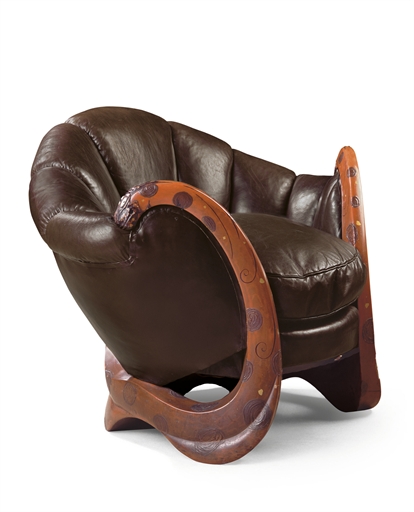
With the extraordinary sale of the Eileen Gray Dragons chair for $28.3 million at the YSL-Bergé auctions last week, we asked a group of dealers, curators, and other 20th century design experts for their reactions. Here are some of their comments:
Liz O’Brien/ Liz O’Brien, New York City
I was thrilled with the result. Everyone expected the Gray pieces to sell well, but no one could have predicted this.
We’ve been talking about these pieces for years. The Dragons chair is so important historically. It was made just after World War I for Gray’s first complete interior design commission, the apartment of a Paris milliner named Mme Mathieu-Lévy, and several of Gray’s best-known designs originated in that project, such as the famous Canoe sofa.
People who admire Gray tend to fall into two camps: those who like her early lacquer pieces, and those who like her work in industrial materials. This is one of her great lacquer designs. The form calls up her fascination with Asian design, but you can also sense the influence of her Celtic roots. Historical photos show that it was originally upholstered in white, and that makes me think of it as a piece of jewelry-the frame is a setting holding a big white pearl.
Barry Shifman/Sydney and Frances Lewis Family Curator, Virginia Museum of Fine Arts
Certainly, Eileen Gray is among the most outstanding art deco designers, so her furniture is highly sought after. Our own collection comprises the largest group of objects by Gray in the United States. And we have her iconic Canoe sofa identical to one made for Suzanne Talbot, who I believe once owned the chair that sold at the YSL-Bergé auction. Gray, who is an “iconic” art deco artist, is so desirable that when a major work by her comes up for auction, we can expect a high price. Obviously two collectors were keen on acquiring the Dragons chair. It was also a bonus that such an eminent fashion designer, Yves Saint Laurent, owned the chair. He was among the most distinguished collectors of art deco. We have seen that the very best, and rarest, art deco objects usually fetch high prices at auction, and there is keen competition among individuals who love this period.
Bob Aibel/Moderne Gallery, Philadelphia
This result shows an excitement about the decorative arts that is long overdue. Many decorative arts pieces have deserved to be sold at fine art price levels, but the market has rarely taken notice. Respect for the decorative arts is still in its infancy. Needless to say, even museums still need to be convinced of the value of decorative arts.
Of course, to put the price for the Dragons chair in its proper context, we would have to know more about the bidders. This sale is about more than a number.
Mark McDonald/Mark McDonald, Ltd., Hudson, NY
My admonishment to collectors has always been, “buy the best condition, the best and rarest example by a great designer and you will not go wrong.” But WOW! I remember hearing the stories of YSL and Pierre, Andy Warhol and Jed Johnson, snapping up wonderful deco furniture in London and Paris in the late 1960’s. They were also blessed with the eye and the opportunity to pursue great pieces long before many of us had a chance or even a clue. This is a thrilling day for decorative arts!
Roberto Polo/Galerie Historismus, Paris
The Dragons armchair is the kind of work that Eileen Gray rejected when she saw Gerrit Rietveld’s designs for the first time. Gray realized that her style until then was merely one of a mannered Parisian decorator and not of a modernist. Later in her life, she would refer to her proto-art déco work of this period as “monsters”. She detested the art déco style, and did not like to be identified with it. Personally, I have never seen a piece as ugly as the Dragons armchair, and can only imagine that the important price it realized was either a vulgar display of bad taste, and lack of artistic culture, or worse, part of a rigged-up sale.
Janet and Gary Calderwood/Calderwood Gallery, Philadelphia
The Gray chair is an extraordinary, iconic piece of 20th century decorative arts. The price it brought should confirm in people’s minds that the line is really blurred between fine arts and decorative arts. No one is shocked by a second- or third-rate painting by a second-tier artist bringing the kind of price the chair brought! People certainly shouldn’t be surprised that one of the icons of 20th century design brings the kind of price it did.
